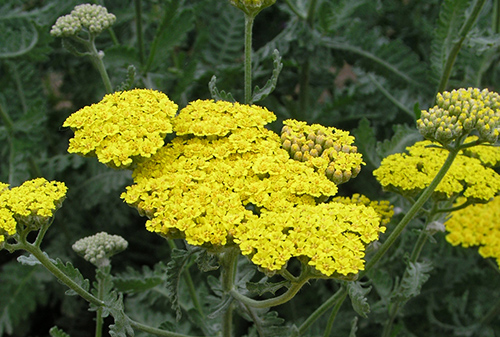Contents
Ancient soldiers and warriors widely used milfoil or achillea because of its healing properties. Over the last few decades, the properties attributed to this plant for more than 2000 years were finally scientifically proven, as well as many others. Milfoil is one of the most used plants in phytotherapy and has many familiar names.
- Introduction: The yarrow plant is also known by many other names, such as carpenter’s plant, bloodwort, knight’s milfoil, old man’s pepper, staunchgrass and nosebleed, to name a few. Aside from its wispy leaves, another distinguishing characteristic of yarrow is its blossoms. Yarrow flowers are tiny and grow in flat-topped composite clusters at the top of the plant’s stems. They flower from June to October, and are either rose- or lilac-colored or white.
- Ingredients: USDA Certified Organic Achillea Millefolium
Milfoil Scientific Facts

- Other names: Noble yarrow, achillea, yarrow, nosebleed, sanguinary, thousand leaf, soldier’s woundwort
- French: Achilee millefuiulle
- Spanish: Milenrama
- Environment: Common in meadows and roadsides all over Europe and spread all over warm regions in America
- Description: Vivacious plant of the Compositae family, growing from 30 to 60 cm high, with leaves divided into acceptable segments and white or pink flowers that gather in umbels. The whole plant has a camphor aroma.
- Parts used medicinally: The flower clusters
Healing Properties and Warnings

The whole plant contains up to 0.8% of essence rich in cineole and azulene. It is supposed to owe its anti-inflammatory, cicatrizant, and vulnerary properties, enhanced by the lack of tannin. It also contains stimulating properties on the digestive system and flavonoids and other glycosides, which give the plant antispasmodic properties. It has a diverse range of uses. Milfoil is highly effective both for internal and external use. The use of this plant is an excellent remedy for the following conditions:
- Digestive issues: Thanks to its bitter component, it acts as an invigorant of the digestive organs, increasing both their action and the secretion of juices required for good digestion. Its effects are more potent for the stomach (where it increases gastric juice production) and the liver (which increases bile secretion). Due to its antiseptic properties, it reduces intestinal fermentation. It is used with good results for chronic gastritis, hypochloridria (lack of juice), dyspepsia (heavy digestion), liver malfunction, digestive spasms, and flatulence. When taken before meals, it has appetizer properties.
- Circulatory issues: Milfoil is an excellent blood depurative, making blood more fluid (by decreasing its viscosity) and enhancing blood flow. It is beneficial for treating arteriosclerosis.
- Female genital issues: Thanks to its emmenagogue properties, milfoil regulates the menstrual cycle when irregular and alleviates dysmenorrhea (spasmodic aches which sometimes accompany menstruation). Due to its hemostatic properties, it helps stop excessive menstruation and uterine hemorrhages.
- Epistaxis: Gauzes soaked in milfoil infusion or fresh juice are packed into the nostrils to stop nose bleeds.
- Antisudorific and deodorant: Footbaths with a milfoil infusion fight terrible foot odor and excess sweat.
- Hemorrhoids: It is an excellent remedy against hemorrhoid inflammation. When hemorrhoids flare up and itch, it reduces their inflammation and volume.
- Acne and eczema: For these cases, good results are achieved when the plant is used in local applications and taken in an infusion.
- Beauty: It promotes the elimination of toxins through the skin, cleansing it. It also improves the appearance of the skin and soothes it.
Since milfoil increases the production of gastric juice, people suffering from gastro-duodenal ulcers should avoid taking it. Also, when taking in high doses, it can produce vertigo and headaches.
The fresh juice of milfoil can produce photosensitization processes (a particular type of allergy) on the skin. The areas treated must be covered so that the sunlight does not reach them for several hours after applying the juice to avoid this reaction.
Preparation and Use
- Infusion with 20g of flower clusters per liter of water. Drink three or four cups daily. It is better to make this infusion soon after harvesting it since it becomes black in color and sour tasting when it is prepared earlier.
- Cleansing and baths with an infusion made with 30-40g of flower clusters per liter of water.
- Nose packing with a gauze soaked in the infusion or the fresh juice of this plant.
- Lotions with the plant’s fresh juice are directly applied to the affected skin area.
- Poultices with the plant, mashed and heated in a pan.
- Compresses with a hot infusion.
When used externally, milfoil is an excellent wound and bruise healer. Also, it possesses antiseptic, cicatrizant, and hemostatic (helps stop bleeding) properties. Dioscorides said it is beneficial “against blood effusion and recent sores.” It is necessary for treating wounds, ulcers, sores, furuncles, chilblains, and cracks. Messegue called it “the iodine tincture of the meadows and greenlands.”
DISCLAIMER: All content on this website is presented solely for educational and informational objectives. It would be best to not rely on the information provided as a replacement for advice, diagnosis, or treatment from a qualified medical expert. If you are pregnant, nursing, or have any preexisting medical concerns, you should talk to your doctor before using any herbal or natural medicines.
References
- George D. Pamplona-Roger, M.D. “Encyclopedia of Medicinal Plants.” George D. Pamplona-Roger, M.D. Encyclopedia of Medicinal Plants. Ed. Francesc X. Gelabert. vols. 2 San Fernando de Henares: Editorial Safeliz, 2000. 691, 692, 693. Print.
- Milfoil Management Handbook, Wisconsin DNR: https://apps.dnr.wi.gov/lakes/invasives/AISLists.aspx?species=EWM
- Integrated Control of Eurasian Watermilfoil, Michigan State Univ. Extension: https://www.invasive.org/browse/detail.cfm?imgnum=0002002
- Journal Article Example (Impact on Fish): https://www.researchgate.net/publication/339380189_Effects_of_Invasive_Watermilfoil_on_Primary_Production_in_Littoral_Zones_of_North-Temperate_Lakes
Last update on 2025-06-04 / Affiliate links / Images from Amazon Product Advertising API





